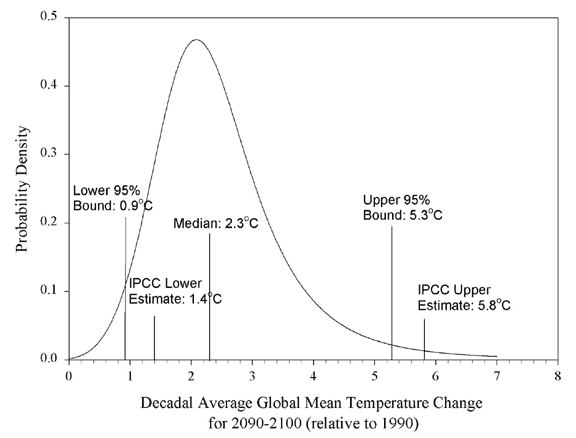 Massachusetts Institute of Technology
Massachusetts Institute of TechnologyMarch 2001 [with revisions 17 July 01] [PDF: 285 kB]
Communicating uncertainty in climate projections provides essential information to decision makers, allowing them to evaluate how policies might reduce the risk of climate impacts. In ongoing work, we use quantitative uncertainty techniques to develop this information. As an illustration of the approach we find that, absent mitigation policies, our median projection shows a global mean surface temperature rise from 1990 to 2100 of 2.3°C, with a 95% confidence interval of 0.9°C to 5.3°C (see figure). The Third Assessment Report (TAR) of the Intergovernmental Panel on Climate Change (IPCC) reports a range for the global mean surface temperature rise by 2100 of 1.4 to 5.8 °C 1 but does not provide likelihood estimates for this key finding although it does for others.
Our assessment applies an integrated earth systems model. 2, 3 The climate model component is a two-dimensional (zonally averaged) model that reproduces the behavior of coupled atmosphere-ocean general circulation models (AOGCMs). 4 This flexibility allows us to analyze the effect of structural uncertainties present in existing AOGCMs. 5 We capture cascading uncertainties in natural and anthropogenic emissions of all climatically important substances, both gases and aerosols, 6 in the critical atmospheric, oceanic, and geochemical interactions, and in the carbon-cycle feedbacks from terrestrial ecosystems and the ocean. Our estimates of key climate model uncertainties are constrained by observations of the climate system for the period 1906-1995, 7 and uncertainty in emissions reflect errors in measurement of current emissions and expert judgment about variables that influence key economic projections.
Our estimated mean global surface temperature increase by 2100 is 2.5°C, reflecting the fact that the distribution is skewed toward high temperature increases. In contrast to our analysis the IPCC does not indicate whether there is a 1 in 5 or 1 in 10,000 chance of exceeding its upper estimate of 5.8°C. Our illustrative results suggest that there is about a 1 in 100 chance of a global mean surface temperature increase by 2100 as large as 5.8°C. A caveat is that unknown and unmodeled processes (surprises) cannot be easily included in our analysis.
For decision-making we are often interested in low probability-high consequence events but it is critical to give some impression of their likelihood. Emissions reductions will lower the chance of exceeding an extreme climate outcome but not eliminate the risk entirely, and analysis of the reduction in probability is an important policy consideration. Our method allows us to calculate a very extreme warming scenario. For example, choosing all the 95% high warming input values, which has a joint probability of 1 in 2.5 million, will lead to a temperature increase of 8.1° C in 2100. Thus, quantifying uncertainty is essential for assessments intended to provide policy guidance.
Our research is not the last word on the likelihood of future climate change. Analysis is hampered by data gaps, inadequate understanding of key earth processes, and inadequate computation power. Still, future reports by the IPCC, and others presenting similar work, would better serve the policy process by including formal analysis of uncertainty for key projections, with an explicit description of the methods used.
A more complete report on this analysis is in preparation.

* The authors are with the Joint Program on the Science and Policy of Global Change, Massachusetts Institute of Technology, Bldg. E40-271, 77 Massachusetts Avenue, Cambridge MA 02139, USA. Email: globalchange@mit.edu. As of 7/2001 Webster is at the University of North Carolina.
[1] Intergovernmental Panel on Climate Change. Working Group I Third Assessment Report: Summary for Policymakers. (2001) www.meto.gov.uk/sec5/CR_div/ipcc/wg1/WGI-SPM.pdf
[2] Reilly, J., R. Prinn, J. Harnisch, J. Fitzmaurice, H. Jacoby, D. Kicklighter, J. Melillo, P. Stone, A. Sokolov & C. Wang. Multi-gas Assessment of the Kyoto Protocol. Nature 401: 549-555 (1999).
[3] Prinn, R., H. Jacoby, A. Sokolov, C. Wang, X. Xiao, Z. Yang, R. Eckaus, P. Stone, D. Ellerman, J.Melillo, J. Fitzmaurice, D. Kicklighter, G. Holian & Y. Liu. Integrated Global System Model for Climate Policy Assessment: Feedbacks and Sensitivity Studies. Climatic Change 41 (3/4): 469-546 (1999).
[4] Sokolov, A., & P.H. Stone. A Flexible Climate Model for Use in Integrated Assessments. Climate Dynamics 14: 291-303 (1998).
[5] Forest, C.E., M.R. Allen, A. Sokolov & P.H. Stone. Constraining Climate Model Properties Using Optimal Fingerprint Detection Methods. Climate Dynamics (in press) (2001).
[6] Reilly, J., Mayer, M., Webster, M. D., Wang, C., Babiker, M. and R. Hyman. Uncertainty in Emissions Projections for Climate Models. in: EOS Transactions, American Geophysical Union, 2000 Fall Meeting (San Francisco: 15-19 December), Supplement (Nov. 28), 81 (48): F22 (2000).
[7] Forest, C., P. Stone, & A. Sokolov. Using Multiple Diagnostics in Climate Change Detection to Assess Climate Model Uncertainty. in: EOS Transactions, American Geophysical Union, 2000 Fall Meeting, Supplement, 81 (48): F101-102 (2000).